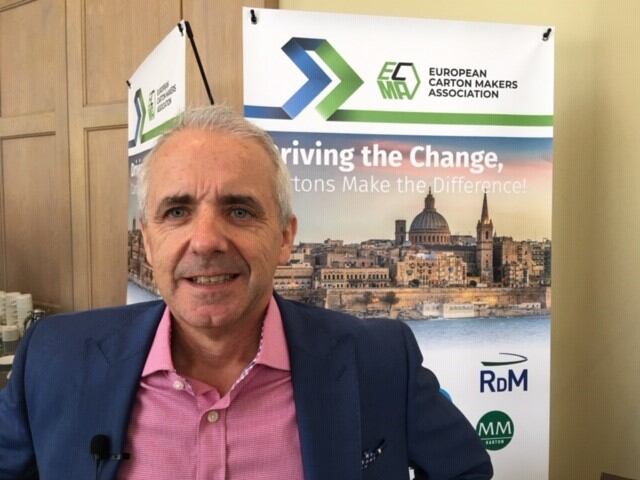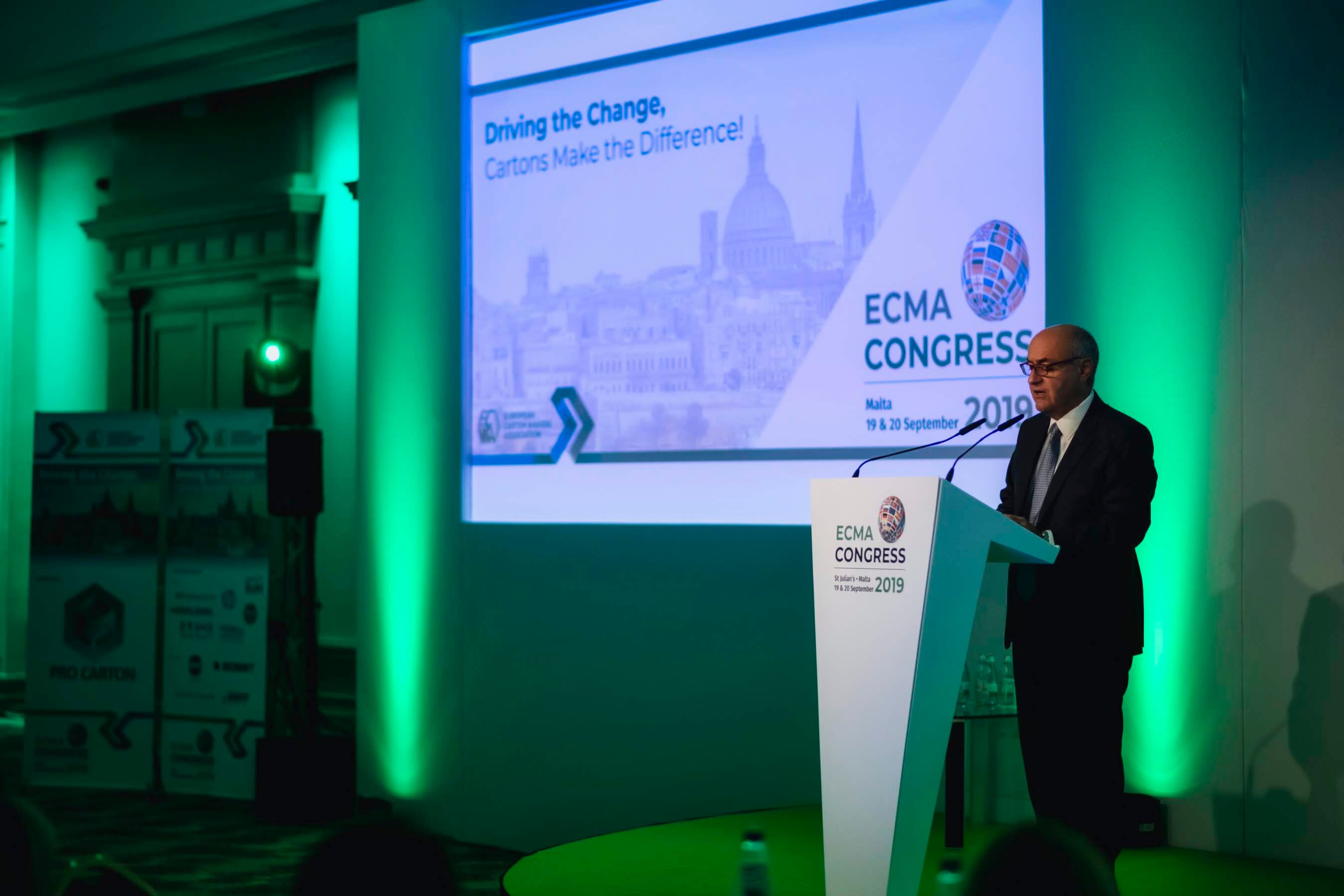With the adoption of the Circular Economy Package in mid-2018 and discussions related to the soon to be adopted SUP Directive, the recyclability of packaging has come to the forefront of public debate.
What is 'Composite’ material

“In relation to the folding cartons manufacturing sector, questions have been raised in respect to the recyclability of coated board cartons; made from cartonboard which incorporates a coating or laminate from a polymer and/or a hot or cold foil to create added functionality or aesthetic value,” said Mike Turner, MD, ECMA, speaking at the recent ECMA Congress in Malta (September 19-20).
“We want to defend the carton industry from legislation that could affect the industry. Some brand owners have their own directives on what type of packaging is and isn’t acceptable regarding cartonboard coated with plastic. That cartonboard is recyclable and we want to make sure the market understands that. Any advice the brands are giving needs to be accurate and we want to slay any negative myths about cartonboard packaging.”
Turner added from a protection perspective, cartons minimise food waste by reducing product damage, food deterioration and premature spoilage.
Some products require specific barrier requirements to be incorporated into the packaging design to further protect the product which cannot be provided by cartonboard alone; for example, to provide a moisture barrier or prevent migration of gases. Depending on the product application and functional requirements, an additional packaging material will be incorporated in to the pack design to provide this barrier, which could be of fossil or biogenic origin.
Such combinations (known as ‘coated cartons’) tend to have a very small percentage of coating (often a polymer) applied to the cartonboard and are preferable to completely plastic-based designs, due to the substantial reduction in plastic use provided by the dual-material and can be recycled.
Sanjay Patel, formerly Coca-Cola Services, founder, Me&Co and founding partner of The Packaging Collective, said confusion still exists around compostability, where different materials breakdown differently in the environment.
The general public, who are largely already educated that cartonboard is fully recyclable, should also know that cartonboard can be placed into existing recycling collection systems. This is also true for the recyclability of cartons with a polymeric layer, he said.
The folding carton manufacturing sector is also working on the development of non-fossil / bio-based alternative solutions for coatings.
5% plastic content
On the other hand, coated cartons should not be considered a ‘composite’ material. When laminated or extruded coated board combinations are used, these combinations of packaging materials can be separated in the recycling process.
This is not dependent on how thick or thin the coating layer is, as long as it is an optimised one so that water can separate it from the fibres. Nearly 100% of the fibres are recovered in the pulping process recovering the material for reuse in another product.
“Cartons with a good fibre quality, and a polymeric layer, are valuable to the recycling infrastructure in Europe and can be entered into the recycling chain,” added Turner.
“However, in certain countries the separate collection of paper and board from other materials is still not fully implemented. The volume of anonymous underground collection in large European cities is increasing. The communication towards households on how to separate in the different streams needs to be further improved.”
Jon Clark, head of procurement, Medica Packaging and GM, BPIF Cartons, said currently the association is in discussions with CPI (The Confederation of Paper Industries) on its recyclability of cartonboard guidelines, on what can and can’t be recycled in cartons.
SUP Directive
The Single-Use Plastic Directive 2019/904 is a legislation aiming to reduce the impact of certain plastic products on the environment. The Directive came into force on July 3, 2019.
There will be EU wide market restrictions (ban) on the following plastic products (Member States shall apply these measures no later than 2 years after the entry into force of the Directive):
- Plastic cotton bud sticks, cutlery, plates, straws, stirrers, sticks for balloons
- All products made of oxo-plastic
- Cups, food and beverage containers made of expanded polystyrene
- The Commission will issue guidelines to help Member States to implement the Directive as well as several implementing acts.
The UK recycling guidelines for paper-based packaging, in partnership with WRAP (Waste and Resources Action Programme) will enable retailers and brands to design and specify packaging to be reprocessed efficiently in paper mills.
They were created as part of a CPI directive to give retailers and specifiers clarification on what the UK paper industry deems readily recyclable.
OPRL (On-Pack Recycling Label), WRAP and DEFRA (Department for Environment, Food and Rural Affairs) are currently consulting on mandatory recyclability labelling on packaging, as currently some cartons products could be labelled as not being recyclable (Metpol/more than 5% plastic content etc.).
“But if the guidelines state the recyclers don’t want more than 5% of weight on a piece of cartonboard because it would not be recyclable but BPIF Cartons disagree,” said Clark.
“OPRL will consider the guidelines when modifying its labels later this year. If the 5% carton weight legislation is implemented it would confuse consumers even more because it would not carry a recyclable label on the cartonboard even though it is recyclable.”
CPI claims the UK recycling guidelines ‘should ‘lead to the optimisation of both the quality and quantity of materials being recycled at paper mills and crucially help create impetus for future technological development in paper packaging materials.’
“Our recyclability guidelines will make it easier for designers and specifiers to identify materials that provide properties such as water resistance while minimising waste. We hope they will provide confidence and direction to the supply chain and benefit the stock of fibre-based packaging being recovered for recycling,” said Simon Weston, director, raw materials, CPI.
Food Contact Materials
According to the Food Packaging Forum (FPF), this month (September 6, 2019), a presentation outlining discussions held at a 'meeting with FCM European Professional Associations' was published on the European Commission’s (EC) FCM Document Library page .
In the presentation, the EC announced an amendment to Regulation (EC) 282/208 on recycling plastics is “under preparation.” The next steps include consultations with EU Member States, the European Food Safety Authority (EFSA), industry and internal EC services.
The EC said without this amendment, “some plastic would be become illegal overnight” when the long-awaited authorization for recycling processes is granted. For example, an extensive “clarification of obligations” still needs to take place. Given the remaining tasks, the EC now plans to adopt individual Authorization Decisions by the third quarter of 2020.
Non-polyethylene terephthalate (PET) materials also require additional consideration. In particular, the EC noted, “because of efficient PET evaluations,” some “time pressure” exists to evaluate these materials, which is further complicated by the “need to avoid inconclusive opinions.”
The EC highlighted there might be “other criteria” or a new procedure established to evaluate non-PET materials, and this proposal may be subject to a public consultation after initial discussion with EFSA and the industry.
The EC has also planned for an amendment to Article 8 of Regulation (EU) No 10/2011, that should state “substances originating from plastic recycling shall be manufactured in accordance with Regulation (EC) No 282/2008.”
The EC also discussed the “glymo” question, referring to the food contact material (FCM) substance [3-(2,3-epoxypropoxy)propyl]trimethoxy silane (CAS 2530-83-8), known to be “potentially genotoxic” and insufficiently regulated at present.
The EC confirmed the need for a specific measure on this substance. A technical draft is currently being prepared that establishes “special conditions of use” that would be “applicable to the manufacture of food contact coatings, adhesives, printing inks, silicones, paper and board, rubber, combinations thereof and combinations with plastics and/or inorganic substances.”
Lastly, the EC gave an update on phthalates. In spring 2019, EFSA held a public consultation on its draft re-assessment of several phthalates in FCMs (FPF reported).
Currently, a dedicated working group at EFSA is “concluding on the updated risk assessment work,” with two main outputs planned, including a “technical report on the consultation” and an “updated scientific opinion” (FPF reported).
The opinion “is scheduled to be adopted at the September CEP Plenary session,” and the EC “will base its risk management of phthalates in FCMs on EFSA opinion” once it is published.
The EC also informed that it “will shortly invite stakeholders to take part in a questionnaire as regards the use of phthalates in FCMs.”

